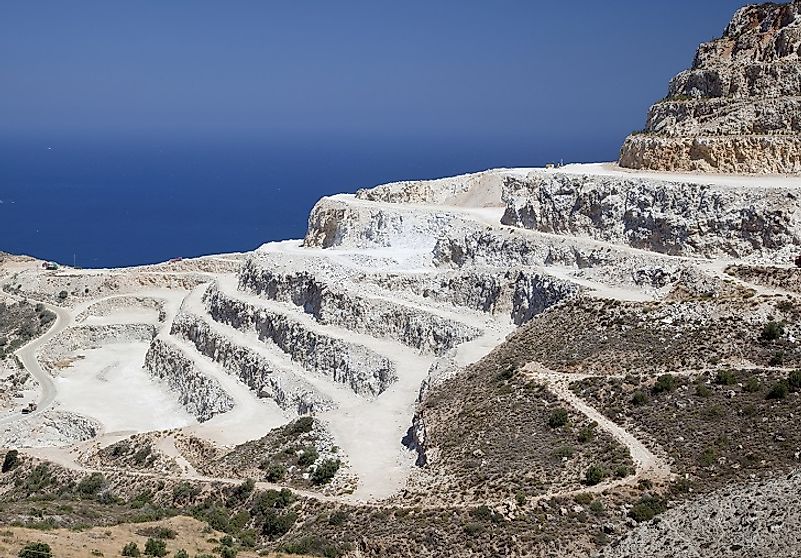Top 10 Chalk Exporting Countries

The primary components making up the chalk is calcium carbonate (CaCO3) a type of limestone that develops from the decomposition of the skeletons of the plankton. Plankton takes the calcium that is naturally occurring in the sea water which precipitates once the plankton dies. On the other hand, Pastel chalks used in art drawing is made from Calcium Sulfate (CaSO4) derived from gypsum (CaSO42H2O).
Usually, scrapers and bulldozers are used to unearth the land that covers the limestone, and if they are near the surface, then open shelf method is employed otherwise open pit quarry is preferable. Under the open pit, holes are drilled into the rocks and explosives are inserted to blow apart the rock. The pit could be enlarged either vertically or laterally depending on the nature of the deposits.
Chalk Processing
When large chunks of limestone have been broken lose in the quarry, they are taken to the crushers where they are grounded and pulverized. It starts with the primary crushing, where the stones are compressed with the cone or jaws, and boulders are shattered and broken to smaller pieces.The second step is the secondary crushing where smaller crushers working at high speed produce pebbles that are grounded and pulverized to produce a slurry for further processing. Finally, it goes through wet grinding to wash away impurities and produce a quality grade limestone required to make the writing chalk. Ball mills that are made up of rotating steel drums with steel balls inside are used in wet grinding to pulverize the chalk to a fine form.
Although gypsum is mined and crushed like limestone, the difference is that gypsum has to be dehydrated to produce calcium sulfate, the primary component of colored chalk. The process takes place in a large combustion chamber called a kettle, where gypsum is heated to between 2440 Fahrenheit and 2530 Fahrenheit. It is kept boiling until it has been reduced by 12% to 15% when the water content falls from 20.9% to between 5% and 6%. Water can be reduced further by reheating to 4020 Fahrenheit. It can be taken out from the kettle because almost all water has been taken out leaving behind calcium sulfate.
Calcium sulfate or the chalk is put in vibrating screens for sifting into fine materials. The resulting chalk is washed clean, dried, and then packaged in bags ready for shipping to different manufacturers. Once in the chalk factory, the chalk or the calcium sulfate will be grounded again to form a fine smooth material.
Top Chalk Exporters and Their Principle Markets
- France is by far the biggest exporter of chalk in the world in 2015 it exported chalk worth $27,690,000. The bulk of the exports were destined to Belgium worth $10,597,000, followed by Germany worth $7,923,000, the Netherlands worth $3,518,000, and Spain worth $1,051,000. The rest are exports to other countries.
- The second largest exporter of chalk in the world is Germany and in 2015, the exports were worth $12,949,000 much of the chalk export were to Poland worth $3,837,000, the Netherlands ($2,147,000), Ireland ($904,000), Belgium ($875,000), the UK ($790,000), and Finland ($776,000). The rest were exports to different countries in the world.
- The third largest exporter of chalk is Belgium, and total exports in 2015 were worth $9,276,000. The principal markets were the Netherlands ($6,178,000), Germany ($1,550,000), Luxembourg ($853,000), Kuwait ($179,000), France ($143,000), China ($95,000), the UK ($69,000), Pakistan ($45,000), and Poland ($42,000), and the rest were exported to various countries.
- The fourth largest exporter of chalk is the Netherlands and the total exports in 2015 were worth $8,691,000. The primary markets for its exports were Belgium ($3,586,000), Spain ($2,061,000), Germany ($638,000), the UK ($587,000), Italy ($210,000), Poland ($198,000), Australia ($181,000), France ($161,000), and Turkey ($142,000). The rest were destined for other countries.
- China was the fifth largest exporter of chalk in 2015. The total exports were worth $7,989,000 and much of ($6,388,000) it going to Macao, an SAR of China, and the rest going to different countries like Thailand ($695,000), Vietnam ($446,000), Indonesia ($306,000), Pakistan ($75,000), Djibouti ($25,000), Kyrgyzstan ($17,000), Russia ($12,000), Saudi Arabia ($12,000), Singapore ($5,000), and Cambodia ($4,000). There were some few exports to Ghana and Turkey as well, each worth around $1,000.
Top 10 Chalk Exporting Countries
| Rank | Country | Chalk Exports in 2015 (USD) |
|---|---|---|
| 1 | France | $27,690,000 |
| 2 | Germany | $12,949,000 |
| 3 | Belgium | $9,276,000 |
| 4 | Netherlands | $8,691,000 |
| 5 | China | $7,989,000 |
| 6 | Spain | $6,295,000 |
| 7 | Greece | $4,978,000 |
| 8 | Saudi Arabia | $4,807,000 |
| 9 | Australia | $4,079,000 |
| 10 | United Kingdom | $3,704,000 |











